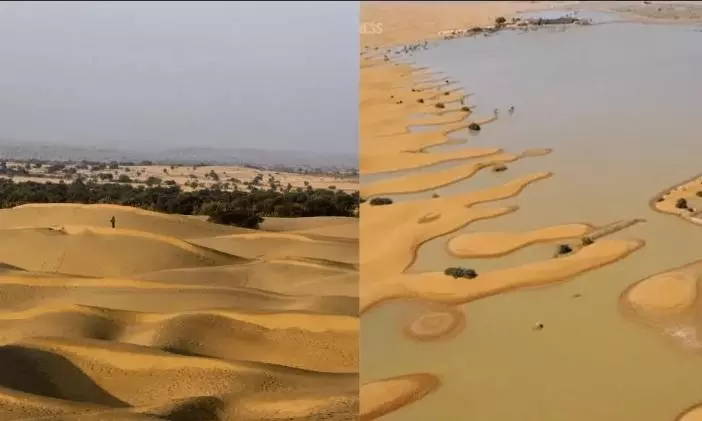
Floods flip Rajasthan’s arid climate; greening of deserts not good sign, say experts
Unprecedented rainfall, floods in Rajasthan call for robust disaster climate action plan, improved disaster management, and revival of traditional water conservation systems

The rising incidences of floods in Rajasthan, which is currently in the grip of heavy rainfall and floods, are a clear indication that the state’s climate, mostly arid, is no longer the same. Experts, however, warn that an increase in rainfall is no reason to rejoice and that it, in reality, can have devastating consequences on the region.
Shift in monsoon pattern
A shift in monsoon patterns, as evident by India Meteorological Department (IMD) data from 1989-2018, has led to an increase in heavy rainfall days, particularly in western Rajasthan, which covers parts of the Thar Desert.
Previous flooding incidents have demonstrated the trend of extreme weather events. The Max Planck Institute has also predicted significant rise in rainfall in the region due to climate change, while stating that the intensity of cyclones in the Indian Ocean would further exacerbate rainfall issues.
Also read: Rain plays havoc across country; 4 die in Himachal, 5 in Rajasthan’s Kota
While the recurring floods have affected the state’s infrastructure, it has taken a heavy toll on transportation, trade and agriculture.
Incessant floods in arid state
This year has seen the state grappling with severe flooding, which is a troubling development for a typically arid state. The heavy rainfall, which began in July, notably affected desert districts like Barmer, Jaisalmer, and Jodhpur. Between July 13 and 16, eastern Rajasthan experienced 135 per cent above-average rainfall, creating flood-like conditions in both urban and rural areas. Roads were submerged, villages were cut off, and thousands of homes were inundated.
The IMD issued alerts, and State Disaster Response Force (SDRF) teams were deployed for rescue operations as the government launched emergency relief efforts. This extraordinary flooding is attributed to climate change, showing its devastating impacts even in drought-prone areas.
Rains pound state, 7 dead
At least seven people have died due to drowning, lightning, and electrocution in the past two days in the state, which is experiencing heavy rains. Six people swept away in the Chambal River are still missing.
Also read: Climate change culprit behind cloudbursts, flash floods, landslides: Expert
On Tuesday (July 15), normal life was thrown out of gear as heavy rainfall pounded the state for the second consecutive day. The downpour left several areas in Jaipur, Churu, Pali, Bikaner, Sri Ganganagar, and Hanumangarh inundated, officials said. According to IMD, the maximum rainfall was recorded in Bijolia in Bhilwara, followed by Bhainsrorgarh in Chittorgarh, Makrana in Nagaur, Niwai in Tonk, Mandana in Kota, and Sambhar in Jaipur.
In Bundi, the Meja River overflowed, cutting off connectivity to multiple villages, while in Jodhpur, train services were impacted due to submerged railway tracks.
Severe waterlogging was reported from Jaipur as water entered homes in several localities. Major traffic snarls were reported across the city, and vehicles on Tonk Road remained stuck for more than an hour.
Also read: World records 2nd-warmest April; global temperature 1.5 °C above pre-industrial levels
The weather department has issued heavy to extremely heavy rainfall warnings for some areas of Kota, Udaipur, Bharatpur, and Bikaner divisions on Wednesday (July 16).
Experts call for robust climate action plan
Experts say the recurrent floods call for an urgent need for strengthened climate action plans, improved disaster management, and the revival of traditional water conservation systems like ‘johads’ and ponds in the region.
They say the state government and policymakers should also create an early disaster warning system at the local level and lay emphasis on reducing carbon emissions and increasing solar and wind energy.
Also read: Climate change bares fangs, unleashes heat-related, vector-borne ailments in TN
Greening of deserts good news or not?
They caution that while increased rainfall in deserts due to climate change might seem beneficial, it's actually unnatural and can lead to negative consequences.
Conservationists say deserts are adapted to arid conditions, and significant rainfall can cause flash floods, soil erosion, and disrupt existing ecosystems. While some deserts are greening due to increased rainfall and carbon dioxide fertilisation, this doesn't negate the potential for ecological damage and is not a universal trend across all arid regions.
(This article was originally published in The Federal Desh)

